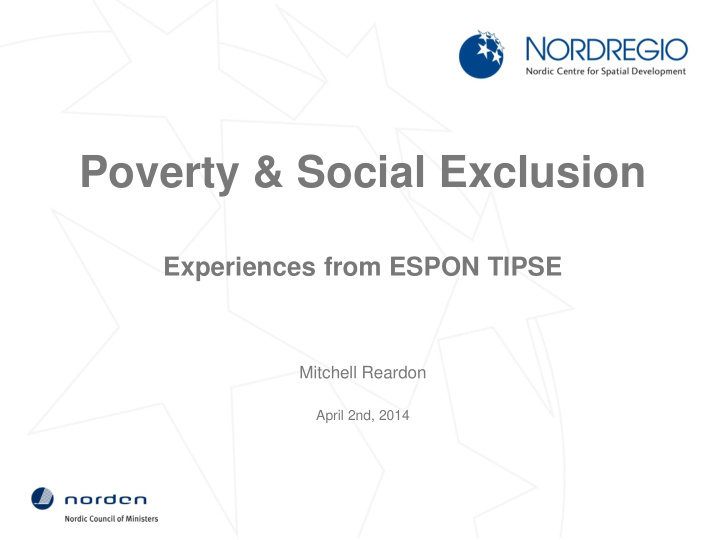



Poverty & Social Exclusion Experiences from ESPON TIPSE Mitchell Reardon April 2nd, 2014
ESPON TIPSE Aim: Generate a regional database, with maps, of poverty & social exclusion indicators Project Lifetime: February 2012 – November 2014 € 750 000 Six Partners
Poverty in Europe? Relatively Straightforward Frequently defined in relative terms in Europe Share of population with Per Cent of Population less than 60% of the 3.4 - 9.9 10.0 - 14.9 Reykjavik ! 15.0 - 19.9 (national) median Canarias ! 20.0 - 24.9 25.0 - 44.3 Guadeloupe Martinique Réunion ! ! ! equivalized household Helsinki ! Tallinn Oslo ! ! Stockholm disposable income Guyane ! ! Riga ! Madeira ! København Vilnius ! ! Minsk ! Dublin ! Acores Warszawa ! Berlin Amsterdam ! Kyiv ! ! London ! ! Bruxelles/Brussel ! Praha Luxembourg ! ! Paris ! Kishinev Bratislava Wien ! ! ! Budapest ! Vaduz Bern ! ! Ljubljana Zagreb ! ! Bucuresti Beograd ! ! Sarajevo ! Sofiya ! Podgorica Skopje Ankara ! ! ! Roma Tirana ! Madrid ! ! Lisboa ! Athina ! Nicosia ! El-Jazair Tounis ! ! Valletta !
Social Exclusion in Europe? Not as easily defined… Representing exclusion at regional scale with Representing exclusion at regional scale with national relativity regional relativity
Social Exclusion in Europe? TIPSE Indicators… Earning a living – Income & employment • 28 indicators Access to basic services – Housing & education • 8 indicators Social Environment – Age, ethnicity, immigrants, household structure • 9 indicators Political Participation – Voting • 1 indicator
TIPSE Results: Cluster Analysis
TIPSE Case Studies Territorially diverse Urban & Rural Five Themes – Education – Unemployment – Access to Services – Ethnic Minorities – Urban Segregation
Urban Case Studies: General findings Significant territorial variation within the urban context – Numerous patterns of exclusion & poverty Territorial fragmentation in Poverty & Social Exclusion – Fine scale necessary, NUTS 3 inadequate Differences in national data collection methods may exacerbate or mask PSE phenomena
Botkyrka Case Study North – South divide – Labour market access & income – Ethnic make up – Mobility – Built form Perception influenced by “hidden numbers” – Informal economy – Nationality or ethnicity? – Paperless persons
Botkyrka Case Study: Approaches that are working Bottom up approach – start with individual Holistic Development – Mandatory Social Impact Assessment Institutions in the community – Library & Schools Start early – Connect with young people
Thank You mitchell.reardon@nordregio.se @mitchellreardon
Recommend
More recommend